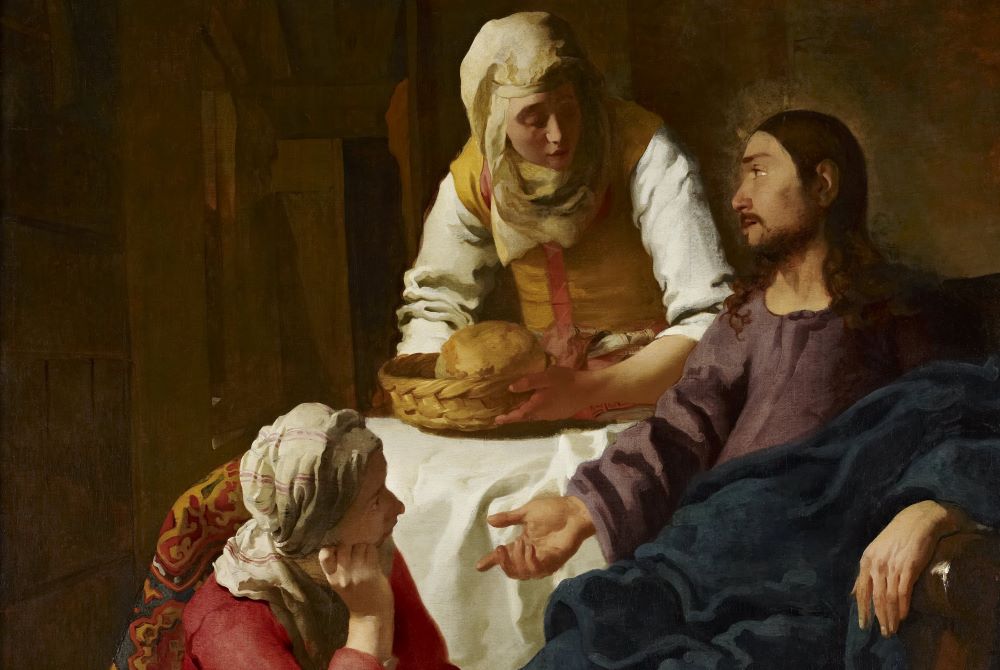
A portion of "Christ in the House of Martha and Mary" by Johannes Vermeer circa 1665 (Wikimedia Commons/Google Cultural Institute)
One of my father's favorite sayings was, "If all else fails, read the instructions." That humorous advice is insightful in its analysis of human behavior, and its subtle underlying message is applicable to most areas of human endeavor: One must sit and listen before one can effectively go and do.
Over the centuries, the story of Jesus in the house of Mary and Martha (Luke 10:38-42) was often misinterpreted as exalting the life of spiritual contemplation and minimizing a life of action. Those interpreters mostly built upon one of the third century theologian Origen's five different interpretations of the story. After all, Martha was "distracted by her many tasks," while Mary "sat at the Lord's feet and listened to what he was saying," and Jesus declared, "Mary has chosen the better part, which will not be taken away from her."
Johannes Vermeer's "Christ in the House of Mary and Martha," for example, subtly depicts the elevation of Mary's spiritual contemplation over Martha's service. Jesus is the focus of the painting, and his authority and divinity are illustrated by the light emanating from his head. Martha, standing to the left and holding a basket of food, looks down at Jesus, and her raised eyebrows ask the question of Jesus that the text of Luke narrates. Mary, in contrast, sits at the feet of Jesus, with her eyes upraised to look at Jesus and her cheek resting on her right hand as she contemplates his teaching. Jesus looks at Martha, and points to Mary, demonstrating that Mary has chosen the better path.
Truly understanding Jesus' radical message creates in us a profound moral obligation to reflect, decide and act accordingly.
Yet Vermeer's painting presents Jesus, Mary and Martha as a unified image in its oval composition of the figures, with Mary and Martha balancing each other with respect to Jesus. Similarly, numerous interpreters have understood that the portraits of Mary and Martha are more complex than they initially appear.
The narrative of Jesus in the house of Mary and Martha, for example, is immediately preceded by the parable of the good Samaritan, which ends with Jesus telling the lawyer to "go and do likewise" to prove to be a neighbor to those in need (Luke 10:25-37). This juxtaposition demonstrates that, as Origen noted elsewhere in a homily on this passage, "there is no action without contemplation, or contemplation without action" (Fragment 171, Homilies on Luke).
What the great theologian Howard Thurman realized, however, is that spiritual contemplation must be the foundation on which action is based. Thurman argued that a fundamental aspect of the religion of Jesus is to sit and listen in the quietness so one can experience the spirit of God and, therefore, ascertain the will of God.
Also key to Thurman's understanding of the religion of Jesus and religious experience itself is his insistence that personal, inner transformation is the foundational first step that leads to all other transformations of self and society. One's inner transformation — the actualization of the presence of God in one's life — includes the building of human relations, and true community should lead to social action. Sitting and listening is a prerequisite for, and must be followed by, going and doing.
As Thurman noted in his autobiography, With Head and Heart, about the church he co-founded in San Francisco, The Church for the Fellowship of All Peoples:
It was my conviction and determination that the church would be a resource for activists — a mission fundamentally perceived. To me it was important that individuals who were in the thick of the struggle for social change would be able to find renewal and fresh courage in the spiritual resources of the church. There must be provided a place, a moment, when a person could declare, "I choose!"
Thurman envisions moving from the spiritual aspects of religious experience to the practical needs in the lives of his congregation and then to the needs of the local and larger community. The motivation for such actions comes from within, from the recognition, as proclaimed by Jesus of Nazareth, that one's religion should be "God-centered," that we should expect "God to invade the normal processes of life," and that "we are called upon to work with [God]."
An essential element of Thurman's argument is that all human beings are children of God in a sacred community of humanity: We act because we become involved in an encounter from the core of ourselves to the core of other human beings, an inward community that then manifests itself as an outward community. Jesus had insisted that "true family," for example, was determined by working relationships (e.g., Mark 3:35: "Whoever does the will of God is my brother and sister and mother").
Advertisement
The life of faith is a journey, and amidst the increasingly hectic world in which we live and with the daunting challenges we face, the story of Mary and Martha reminds us once again that we must sit and listen at the feet of Jesus before we go and do. Only then can we, as Thurman notes, have the renewed strength, courage and wisdom for that journey.
Both Mary and Martha, then, are examples of discipleship to be emulated. Mary can be seen as a paradigm of what it means to follow the first great commandment, to love God with all our heart, soul, mind and strength, whereas Martha illustrates the second great commandment, to love one's neighbor as oneself (Luke 10:27).
The story of Mary and Martha illustrates that the proper response to the teachings of Jesus is, first, to sit and listen, to reflect, experience and understand. But an authentic engagement with the teachings of Jesus involves more than intellectual assent; it means "to go and do." Jesus' teachings not only challenge us to act; they demand that we act: to "go and do likewise, as Jesus instructed the lawyer just before making his way to Mary and Martha's house.
Understanding must lead to concrete action in the world, because truly understanding Jesus' radical message creates in us a profound moral obligation to reflect, decide and act accordingly, whether by working for civil and human rights, promoting justice in the midst of oppression, seeking peace among those who advocate for war or, in other words, proclaiming Jesus' good news to the poor, release to the captives and liberation of the oppressed (Luke 4:18).






